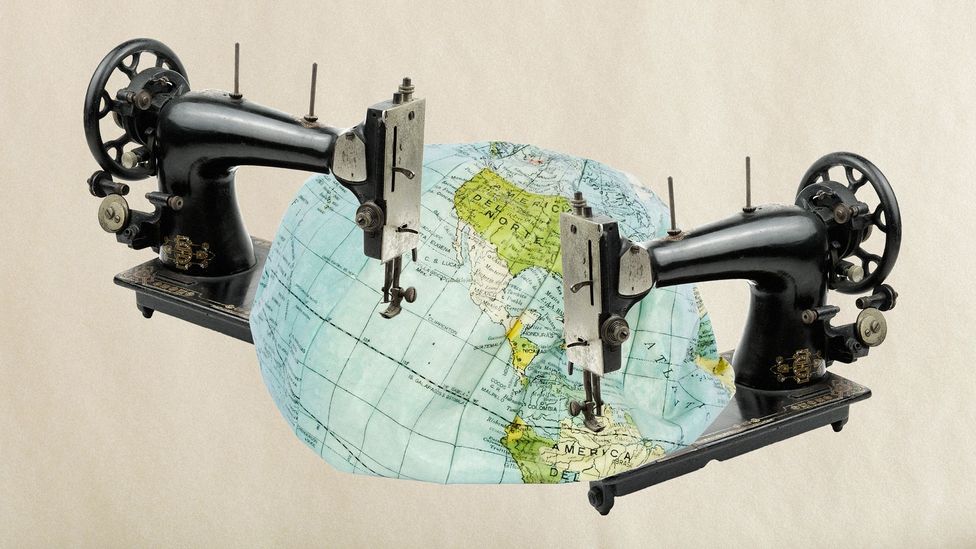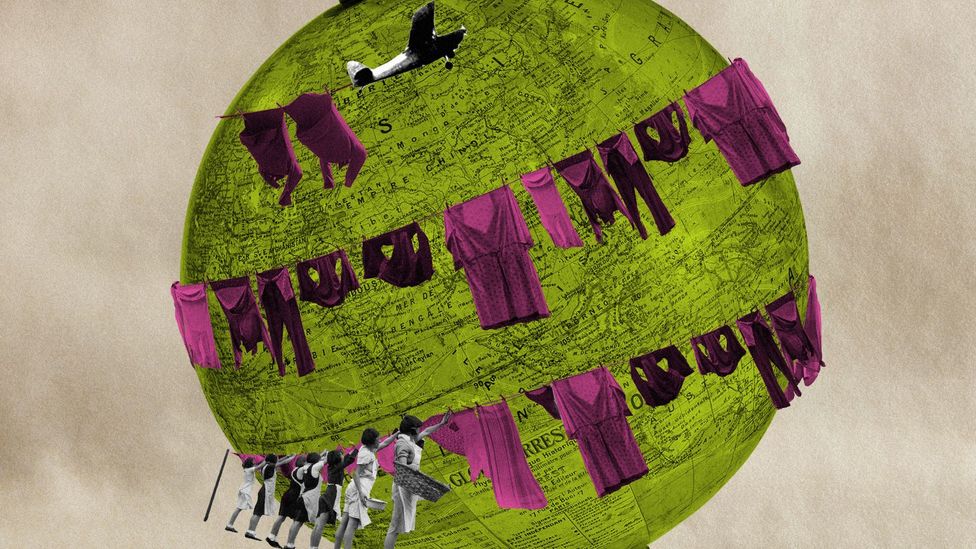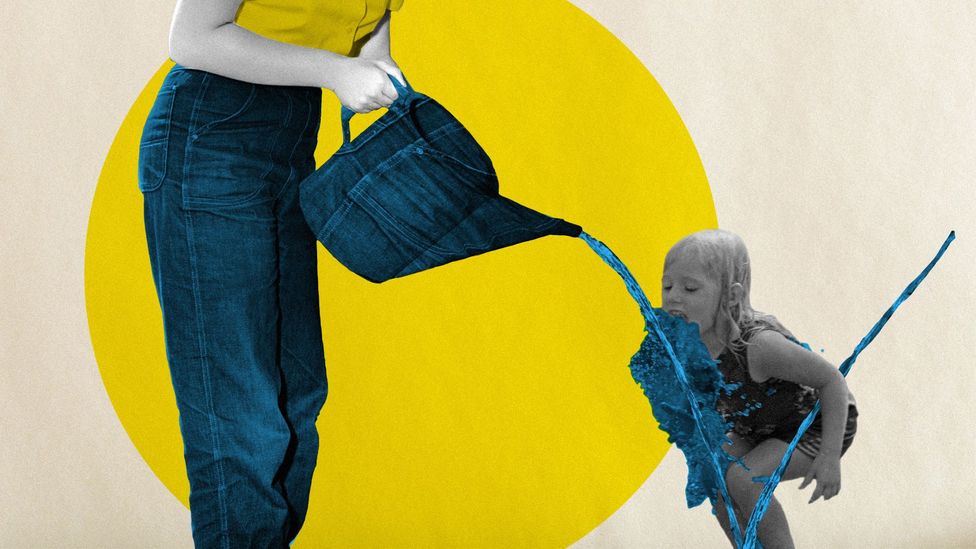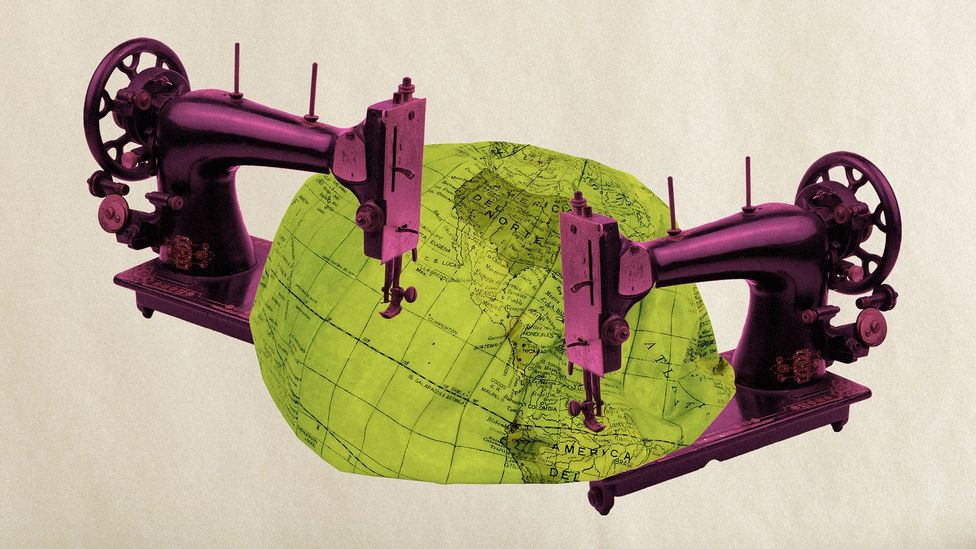Old Fashioned Way to Unclog Drains
Can manner e'er be sustainable?
(Paradigm credit:
Alamy/Javier Hirschfeld
)

Fashion accounts for around 10% of greenhouse gas emissions from human being activity, simply there are ways to reduce the impact your wardrobe has on the climate.

"For years I was obsessed with buying clothes," says Snezhina Piskova. "I would purchase 10 pairs of very cheap jeans just for the sake of having more multifariousness in my wardrobe for a low price, fifty-fifty though I ended up wearing only two or three of them."
When it comes to resisting the lure of fashion, Piskova faces a tougher challenge than almost. As a copywriter for a visitor in the fashion industry she's surrounded by fashionistas. And information technology's been easy to go along with the tide.
But conversations about the climate crisis made Piskova, who lives in Sofia, Bulgaria, consider the bear upon that the industry and her own shopping habits were having.
The fashion manufacture accounts for well-nigh 8-10% of global carbon emissions, and about 20% of wastewater. And while the environmental impact of flying is at present well known, way sucks up more energy than both aviation and shipping combined.
You lot might likewise like:
● Should you continue a "flight diet"?
● Why your bin is a climate problem
● The surprising cost of being online
Vesture in general has complex supply chains that makes information technology difficult to account for all of the emissions that come up from producing a pair of trousers or new coat. Then in that location is how the wear is transported and disposed of when the consumer no longer wants it anymore.

The fashion industry is responsible for more carbon emissions than those that come from aviation (Credit: Getty Images/Alamy/Javier Hirschfeld)
While about consumer goods suffer from similar issues, what makes the way manufacture especially problematic is the frenetic pace of alter it non only undergoes, but encourages. With each passing season (or microseason), consumers are pushed into ownership the latest items to stay on trend.
It's hard to visualise all of the inputs that go into producing garments, merely let'due south accept denim as an instance. The United nations estimates that a single pair of jeans requires a kilogram of cotton. And because cotton tends to be grown in dry out environments, producing this kilo requires about 7,500–10,000 litres of h2o. That'southward nearly ten years' worth of drinking water for one person.
There are means to brand denim less resource-intensive, but in general, jeans composed of material that is as close to the natural state of cotton every bit possible employ less water and hazardous treatments to produce. This ways less bleaching, less sandblasting, and less pre-washing.
Unfortunately it also ways that some of the most popular types of jeans are the hardest on the planet. For example, cloth dyes pollute h2o bodies, with devastating effects on aquatic life and drinking water. And the stretchy elastane material woven through many trendy styles of tight jeans is made using synthetic materials derived from plastic, which reduces recyclability and increases the environmental touch further.
Jeans manufacturer Levi Strauss estimates that a pair of its iconic 501 jeans volition produce the equivalent of 33.4kg of carbon dioxide equivalent across its entire lifespan – about the aforementioned as driving 69 miles in the average US car. Merely over a third of those emissions come from the fibre and fabric product, while some other viii% is from cutting, sewing and finishing the jeans. Packaging, transport and retail accounts for 16% of the emissions while the remaining 40% is from consumer use – mainly from washing the jeans – and disposal in landfill.
Another study of jeans made in India that contained 2% elastane showed that producing the fibres and denim fabric released 7kg more carbon than those in Levi'due south analysis. It suggests that choosing raw denim products will take less impact on the climate.
But it is also possible to look for further ways of reducing the bear on of your jeans by looking at the label. Certification programmes similar the Better Cotton fiber Initiative and Global Organic Textile Standard can aid consumers work out how green their denim is (although these programmes aren't perfect – many endure from a lack of funding and the circuitous supply bondage for cotton tin make it hard to account where it all comes from).

Growing the cotton needed for a single pair of jeans requires a huge corporeality of water, while dying and manufacturing processes use yet more than (Credit: Getty Images/Javier Hirschfeld)
Some manufacturers are too working on ways to reduce the environmental impact from the production of their jeans, while others have been developing means of recycling denim or even jeans that will decompose within a few months when composted.
It'due south not cotton wool, but the synthetic polymer polyester that is the most common fabric used in clothing. Globally, "65% of the wear that we wear is polymer-based", says Lynn Wilson, an adept on the round economic system, who for her PhD enquiry at the University of Glasgow is focusing on consumer behaviour related to wearable disposal.
Around 70 million barrels of oil a yr are used to make polyester fibres in our clothes. From waterproof jackets to frail scarves, information technology's extremely difficult to get abroad from the stuff. Part of this stems from the convenience – polyester is easy to clean and durable. Information technology is besides lightweight and inexpensive.
But a shirt made from polyester has double the carbon footprint compared to ane fabricated from cotton wool. A polyester shirt produces the equivalent of five.5kg of carbon dioxide compared to 2.1kg from a cotton shirt.

Swapping clothes with friends can refresh your wardrobe and bring an interesting new dimension to your friendship (Credit: Getty Images/Javier Hirschfeld)
A uncomplicated fashion to reduce the footprint from online shopping then is to only order what we really desire and intend to go along. According to the World Bank, 40% of wearable purchased in some countries is never used.
Piskova has tried to move away from the fast manner civilisation herself by learning to appreciate what she already has rather than what she could have. But detaching herself from a way-obsessed mindset hasn't been easy. To assistance, Piskova resists going to places where she feels pressure level to consume, such as shopping malls. She also periodically swaps clothes with her friends, which non just allows them to refresh their own wardrobes but too helps them feel closer to each other. And she has also learned to comprehend small blemishes on her dress, rather than seeing these as an excuse to buy more.
"People are so careful with their clothes, like to not have whatever scratches on them or have any holes or whatsoever," says Piskova. "But and then when you lot call back about it, that's office of the apparel. You remember that one time when y'all went to a festival, where you ripped your shirt or something like that, and it's a nice memory."
The number of times you vesture an item of vesture can make a large deviation likewise in its overall carbon footprint. Inquiry by scientists at the Chalmers Constitute of Applied science in Gothenburg, Sweden, constitute that an average cotton t-shirt might release just over 2kg of carbon dioxide equivalent into the temper while a polyester dress would release the equivalent of nearly 17kg of carbon dioxide.

Sometimes the best way to reduce the bear on your fashion choices have on the environment is break costless of the herd (Credit: Getty Images/Javier Hirschfeld)
They estimated, even so, that the average t-shirt in Sweden is worn around 22 times in a yr, while the average clothes is worn simply 10 times. This would mean the amount of carbon released per wear is many times college for the apparel.
According to the Ellen MacArthur Foundation, the boilerplate number of times a piece of wearable is worn decreased by 36% between 2000 and 2015. In the same period, clothing production doubled. These gains came at the expense of the quality and longevity of the garments.
A number of public surveys besides suggest that many of united states of america take clothes in our wardrobes that we hardly ever wearable. According to i survey, well-nigh half of the dress in the boilerplate UK person'due south wardrobe are never worn, primarily because they no longer fit or have gone out of style. Some other plant that a 5th of the items owned by U.s.a. consumers are unworn.
It is clear that investing in higher-quality clothing, wearing them more often and holding onto them for longer, is the not-then-secret weapon for combatting the carbon footprint from your garments. In the UK, standing to actively wear a garment for just 9 months longer could diminish its environmental impacts past xx–30%.
Naturally, some clothing companies have sniffed out an opportunity here. Clothing rental services, for instance, are especially appealing in a social-media era where some people are reluctant to be seen online wearing the aforementioned outfit more than once. For those who want to look expert in their online photos but have even less of an impact on the environment, there is the ephemeral tendency for digital style, or clothing designed to just appear online by being superimposed onto your images.
Buying less as well means caring for wearing apparel more than. Websites similar Love Your Clothes, gear up up by Great britain recycling clemency WRAP, offer tips on repairing and extending the life of clothes, which tin can reduce the carbon footprint of the clothes.
Merely tackling the underlying reasons for why we over-purchase, yet underuse, wearing apparel could also help. In a consumerist social club, people are trained to discover fast fashion pleasurable and addictive.
"A lot of the things that we purchase fulfil some kind of function in ourselves – particularly style items," says Mike Kyrios, a clinical psychologist who researches mental disorders at Australia'southward Flinders University. People who accept lower self-esteem or worry about their status are peculiarly likely to use overspending as a route to experience similar they "belong", he explains. Every bit are people who are sensitive to rewards – indeed the advantage centres in the brain are those well-nigh activated past impulse shopping.
Online shopping also means that the impulse to buy is harder to command, equally internet stores are open up 24/7 – including, as Kyrios says, the times "when your decision-making capabilities are at their minimum".
Though estimates vary, one is that about v% of the population exhibits compulsive buying behaviour. "The trouble is it'due south well hidden," says Kyrios. "People don't evidence upwards for treatment, people don't acknowledge information technology'southward a trouble."
One solution might be to simply ration the time yous spend looking at clothes online, simply perhaps a better approach is to find less wasteful means of achieving the sense of reward that over-spenders are seeking. Mainstream consumers can scratch their itch for new dress by buying from vintage and secondhand clothing shops.

Wearing our garments for even merely a few months longer can reduce the impact they have on the planet (Credit: Alamy/Javier Hirschfeld)
"Secondhand clothing is giving clothes a 2d life and it'due south slowing down that fast-mode bike," says Fee Gilfeather, a sustainable fashion adept at charity Oxfam. "And so I would say secondhand (clothing) is actually one of the solutions to the overconsumption challenge."
Cutting down on washing can besides help to farther reduce the carbon footprint of your wardrobe, while besides helping to lower h2o utilize and the number of microfibres shed in the washing machine.
"You don't need to wash dress equally often equally you might think," says Gilfeather. She hangs some of her dresses out to air, for example, rather than washing them after each habiliment. "Reducing the amount of washing that you need to do is the best mode of making sure that the plastics don't get into the water system."
How y'all dispose of the clothes at the finish of their useful life is also important. Throwing them away so they end upward in landfill or being incinerated simply leads to more emissions. Perhaps the best arroyo is to pass them on to friends or take them to charity shops if they are notwithstanding good enough to exist worn. However, individuals should exist careful not to use this as a mode of immigration space simply to buy new clothes, which Wilson'southward research suggests is mutual.
Where clothing has been worn or damaged beyond repair, the most environmentally sound fashion of disposing them is to send them for recycling. Wearable recycling is withal relatively new for many fabrics merely increasingly cotton and polyester wearable can at present be turned into new wearing apparel or other items. Some major manufacturers have now started using recycled fabrics, merely it is often difficult for consumers to find places to have their sometime dress.
Many of the changes needed to make vesture more sustainable accept to be implemented by the manufacturers and big companies that command the style industry. But every bit consumers the changes we all make in our behaviour not only add up, but tin bulldoze alter in the industry, too.
Co-ordinate to Gilfeather, we tin can all make a difference by being more than thoughtful as consumers.
--
Smart Guide to Climate Modify
For near BBC Future readers, the question of whether climate change is happening is no longer something that needs to exist asked. Instead, at that place is at present growing business concern about what each of us every bit individuals can do about it. This new series, our Smart Guide to Climate Change, uses scientific enquiry and information to break downward the most effective strategies each of us can accept to shrink our carbon footprint.
--
Join 1 million Future fans past liking u.s.a. on Facebook , or follow us on Twitter or Instagram .
If yous liked this story, sign up for the weekly bbc.com features newsletter , chosen "The Essential Listing". A handpicked selection of stories from BBC Hereafter, Culture, Worklife, and Travel, delivered to your inbox every Friday.
0 Response to "Old Fashioned Way to Unclog Drains"
Post a Comment